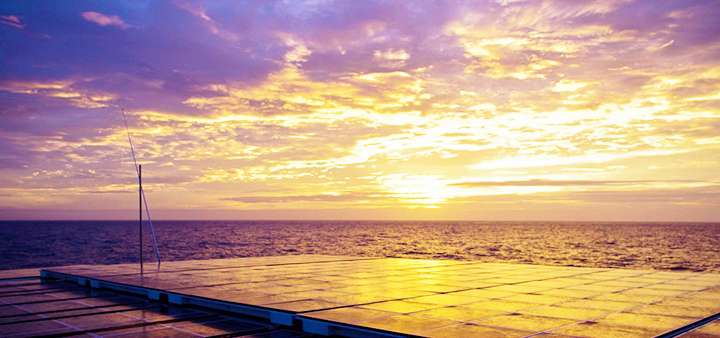PlanetSolar DeepWater Scientific Expedition Returns To Europe
Originally published on 1Sun4All.
The solar catamaran PlanetSolar has successfully made its second transatlantic crossing this year, returning to Europe. MS Tûranor PlanetSolar reports: “Having left St. John’s, Canada, on August 6, the largest solar ship in the world reached Europe on August 28, after crisscrossing the North Atlantic for 23 days and traveling 4598 kilometers. During the second 2013 transatlantic crossing, the collection of scientific data carried as part of the ‘PlanetSolar DeepWater’ expedition continued.”
The following is an official news release from PlanetSolar:
MS Tûranor PlanetSolar reaches Europe and stops in Oostende, Belgium
PlanetSolar in St-John’s, Canada, the most northernmost point the solar vessel has ever reached. | © All rights reserved PlanetSolar
Transformed into a scientific platform, the ship enabled a team of researchers from the University of Geneva (UNIGE) to take advantage of her exclusive features in order carry out an exclusive campaign of physical and biological measurements along the Gulf Stream. A series of events will be held onboard the ship, which will remain moored at Tijdok dock, Oostende, Belgium, until August 30, before setting sail for London in the United Kingdom.
The MS Tûranor PlanetSolar returned to the old continent after 23 days of navigation. At an average speed of 4.5 knots, travelling 4598 kilometers across the North Atlantic proved to be difficult in terms of navigation.
“The weather conditions were particularly unfavorable during this crossing! The wind, first during our southern descent, then the current, and finally a much lower than average amount of sunshine in the region for this time of year!” said Gérard d’Aboville, captain of the ship.
The “PlanetSolar DeepWater” scientific expedition’s last phase of measurements will begin in Oostende. “The final phase is of particular interest because data will be collected on the outskirts on an urban area. We have already observed some very interesting results around Boston. I look forward to discovering what measures will be taken around the British capital,” explains Jérôme Kasparian, UNIGE researcher and member of the expedition’s scientific committee.
Sunset on the North Atlantic voyage | © All rights reserved PlanetSolar
 Chip in a few dollars a month to help support independent cleantech coverage that helps to accelerate the cleantech revolution!
Chip in a few dollars a month to help support independent cleantech coverage that helps to accelerate the cleantech revolution!
Alongside the events dedicated to local authorities, the net destined for use during the floating plastic waste collection campaign (carried out in collaboration with Waste Free Oceans) will be tested during the Belgian stop.
Next, the ship will leave for London, United Kingdom, the stopover which will conclude the phase of exclusive measurements conducted as part of the “PlanetSolar DeepWater” scientific expedition
The “PlanetSolar DeepWater” scientific expedition
Launched in Florida in early June, the “PlanetSolar DeepWater” expedition covered over 8,000 kilometers, using advanced instruments and the expertise of the UNIGE scientists to collect a continuous series of physical and biological measurements along the Gulf Stream, both in the water and in the air. Led by Professor Martin Beniston, the research team studied the key parameters of climate regulation, namely aerosols and phytoplankton, in order to better understand the complex interactions between the ocean and the atmosphere, as well as the role these interactions play in climate change.
The researchers were particularly interested in the phenomenon of ocean vortexes—large whirlpools that break away from the main part of the Gulf Stream—that influence heat exchanges with the atmosphere as well as the behavior of phytoplankton.
Sunset in the Atlantic, near the halfway point of the DeepWater crossing | © All rights reserved PlanetSolar
From the ships blog, Gustavo Sousa writes: For the next two days, we sailed with clouds above us, sometimes with the sun saying hi, but those were rare moments, and at night we couldn’t see anything. Until Friday night, when the clouds finally went away, and I saw the most beautiful sky that I had seen in a long time, perhaps in my whole life. I could see stars that would be impossible to see inland, even with a telescope because of the light pollution, complete constellations maybe like our ancestors saw when they named them, giant castles in the sky that I could stare at forever… if I wasn’t tired and if it was a little bit warmer outside.
Have a tip for CleanTechnica? Want to advertise? Want to suggest a guest for our CleanTech Talk podcast? Contact us here.
Latest CleanTechnica.TV Video

CleanTechnica uses affiliate links. See our policy here.




